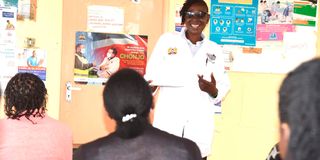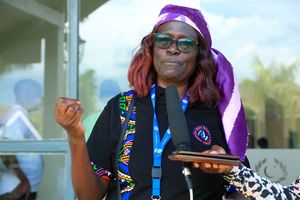Inside quest to end HIV transmission to babies

Alice Otieno delivers a health talk to patients at the Bondeni Dispensary in Nakuru County on November 14, 2023, where she serves as an adherence counselor. Her main focus is to ensure that mothers living with HIV give birth to healthy children.
What you need to know:
- Her husband died two weeks after admission, and that’s when reality sank in for Mueni.
- She returned to Nakuru and this time she had to confront her worst fears — getting her eight-year-old sickly child tested for HIV.
A routine trip to get family planning services at the Nakuru Level 5 Hospital in 2002 would open Pandora's box for Faith Mueni*. She had a four-year-old child by then and was urged by her neighbours to stop by the Voluntary Counselling and Testing (VCT) centre at the facility. She went there with some of them.
VCT was a new feature at the hospital, and the conversations around HIV and Aids then were still being had in hushed tones. Mueni patiently waited for her turn to get tested, not knowing that the outcome would shake to the core her world as she knew it. “I recall getting tested, and as the counsellor was still speaking with me, I stole a glance at the test kit. When I saw the two lines that indicated a positive result, I became restless,” she recounted.
She stood up, walked out, and then came back into the clinic, all of this in quick succession.
“I could not believe it. I had a healthy child and I wasn’t sick. So, how could I test positive for HIV?” she recalled.
Her neighbours, having noticed something was amiss, left her alone at the VCT centre. The walk back home was excruciatingly slow and hazy. “I felt like a train was crossing through my mind. I had resolved that I must have been infected with the virus by my husband since I had caught him previously with infidelity,” she added.
Even after raising hell to her husband that evening, he found a way to cajole her, saying that since the HIV test she had taken at the public hospital was free, then it must have been faulty. “I believed him”, she said with a silly smirk, “because I could not make sense of what was happening and we were still very healthy.”
Mueni’s husband got a job in Nairobi as a supermarket attendant and the family relocated.
However, in 2006, her husband started developing pneumonia frequently. He also developed a growth on his neck. When his health deteriorated, her in-laws prevailed upon them to move to a hospital in Webuye, Bungoma County, her husband’s ancestral home. “When he was being admitted, they had to test us again for HIV. That’s when I got the confirmation,” she said.
Husband dies
Her husband died two weeks after admission, and that’s when reality sank in for Mueni. She returned to Nakuru and this time she had to confront her worst fears — getting her eight-year-old sickly child tested for HIV. “I took him back to the Nakuru Level 5 Hospital for testing. The results came back positive. I was crushed,” Mueni noted.
Mueni’s son had a CD4 count of 208 and was immediately put on anti-retroviral medication. A young adult today, he is still taking the medicines. “Since then, I became actively involved in disseminating HIV-related information. I underwent training and I specialised in prevention of mother-to-child transmission as a mentor-mother,” she explained.
In 2012, Mueni remarried. Her partner was also living with HIV. When they decided to have a child, she was now more prepared to have a HIV free-child. “I look at my daughter with so much pride. It’s like life gave me a second chance through her. I have mentored so many mothers with my story of having two children with different HIV statuses,” she said.
Another campaigner
Apart from Ms Mueni, there is Alice Akinyi Otieno who is a big campaigner on preventing mother-to-child transmission. She often gives talks at Nakuru’s Bondeni Dispensary, especially at the antenatal clinic. Her talks make the difference between a HIV-positive mother delivering a HIV-negative child and her infecting the newborn.
She works as an adherence counsellor, and her passion stems from a very personal experience. At 22, Alice’s health started deteriorating while living with her parents in Homa Bay County. She had been diagnosed with tuberculosis and was put on treatment. She, however, fell off treatment. “I took the TB medication for two months or so. When my health improved, I stopped,” she said.
This prompted her mother to send her to Nairobi where she would get better healthcare at the Kenyatta National Hospital. “I learnt about my HIV status in the crudest of ways. That was back in 2002. I had TB and had gone for testing at the Kenyatta National Hospital. The lab technician just handed me a slip with my results, told me my haemoglobin was low, and said that I needed to boost it with iron-rich foods,” she said.
It’s the reaction from a relative who was then housing her that threw her off-balance.
“(The relative) called home and told everyone about my HIV status without my knowledge. I was then told to leave the house,” she said. Alice found her way back home but it would take a relapse of a bout of tuberculosis and two years for her to get on anti-retroviral medication. “I was craving that care and I did not want to die,” explained Alice.
In 2005, Alice got into a relationship. Her partner was also HIV-positive. Three years later, in 2008, they welcomed their first child. Unfortunately, the boy died at eight months. “When I was pregnant, I did not know there was a procedure I was required to follow. I also don’t know if he died from HIV or not,” she explained.
When she conceived for a second time, Alice made sure to follow through the antenatal care for mothers living with HIV. This time, she delivered a HIV-free child.
“I conceived once again in 2014 and delivered a HIV-free child,” she said. For the last 17 years, Alice has dedicated herself to ensuring no mother living with HIV delivers a child who is HIV positive. “It usually pains me when a child tests positive for HIV. Sometimes the mother comes for the antenatal clinic quite late in the third trimester and by then the interventions might not work. The other thing is failure to exclusively breastfeed the child for six months,” she explained.
According to the National Syndemic Diseases Control Council (NSDCC), Kenya fell short of meeting the target to reduce mother-to-child HIV transmission rates to less than five per cent by 2020. The current national HIV mother-to-child transmission stood at 8.6 per cent as of 2022. In Nakuru County, HIV transmission from mother to child is higher than the national average, standing at 10.7 per cent. That means that 11 in every one hundred HIV-positive mothers transmit HIV to their children during pregnancy, labour and delivery, or while breastfeeding.
According to the Nakuru Health department, there were 2,666 children below 15 years old living with HIV in 2022. This number has since risen to 2,966. New infections within the same age bracket rose from 241 to 282, and the need for prevention of mother-to-child transmission rose from 2,142 to 2,634 mothers.
This has seen the county launch a 100-day rapid results initiative in a bid to end Aids in children by 2027 in line with the national launch that was done on September 8 in Homa Bay County by Health Cabinet Secretary Susan Nakumicha. Nakuru County’s executive committee member for Health, Dr Jacquiline Osoro, attributed the rise in HIV infection in children to the Covid-19 pandemic and the post-pandemic aftershocks.
“During pandemic lockdowns, there was a rise in HIV infections because people could not access care. For us to stop HIV transmission from mother to child, we want to use the community health promoters to go house-to-house, creating HIV awareness,” she said. In the 100 days between October and December, Nakuru will look at its 3,306 community health promoters in the pursuit of two goals.
One is to bring down the HIV infection in young children under the age of 15. Another one is to address infection among teenagers and young adults aged 15-29 who were identified by the NSDCC as a key population driving new HIV infections in the country (by 52 per cent in 2022). NSDCC also identified a triple threat of early pregnancies, new HIV infections and gender-based violence to be most prevalent among young people.
“We realise even from Nakuru, the increase in HIV infections is from the youth. If we have to fight HIV, we have to start there. The youth are more scared of HIV than pregnancy. It has a ripple effect when you can fight HIV and early pregnancies,” said Dr Osoro. According to the Joint United Nations Programme on HIV/Aids (Unaids), 1.2 million children and adolescents living with HIV (0-19 years) in the world are untreated.
It notes that one of the most glaring disparities of the Aids response to date is the failure to provide life-saving treatment to children and adolescents.
End by 2027
The “Kenya Plan to End Aids in Children by 2027”initiative hopes to achieve numerous objectives by 2027. One of them is reducing the rate of mother-to-child transmission of HIV from 8.6 per cent to below five per cent. Another goal is to increase and sustain treatment coverage among pregnant breastfeeding women, children and adolescents living with HIV to not less than 95 per cent.
The plan also aims to increase and sustain HIV viral load suppression among not only pregnant breastfeeding women but also children and adolescents living with HIV to no less than 95 per cent within that period.
Another objective is to reduce new HIV infection among adolescents and young people by 75 per cent by 2027.
All these are ambitious plans, but the Ministry of Health’s recent rollout of 100,000 community health promoters is expected to go a long way in ensuring Kenya achieves her target of reducing the prevalence of Aids in children in the next four years. For Alice and Mueni, the task ahead is huge but possible. Both of them are testaments of triumph against a virus that three decades ago would have spelt death for them and their children.
“I have had two cases of mothers I had mentored while pregnant having their children turn HIV-positive. When this happens, it’s a personal loss to me. I usually feel like I have failed,” said Mueni. Alice added that stigma is still prevalent, as much as access to information about HIV and how it is transmitted has improved.
“My biggest concern when a child turns positive is if they will be consistent in taking their ARVs all through their lives,” Alice pondered.
Alice also noted that the rise in HIV infections among young adolescents and adults could be due to HIV-positive youth not disclosing their statuses to their partners and discontinuing their medication.
“Having worked in a prevention of mother-to-child transmissions clinic, I have seen mothers coming to take medication and not following the instructions. For the teenagers living with HIV, they come in during the third trimester and by this time it’s too late to intervene,” said Alice.
“My older child who is living with HIV has faced stigma nearly all his life, especially as a teen. There was a time I found out he had stopped taking his ARVs. I had to take him for counselling for him to see the importance of the ARVs. They are his lifeline,” added Mueni. Unsaid says some of the factors that hinder access to care for women, adolescents and children are stigma, discrimination, punitive laws and policies, violence and entrenched societal inequalities.





